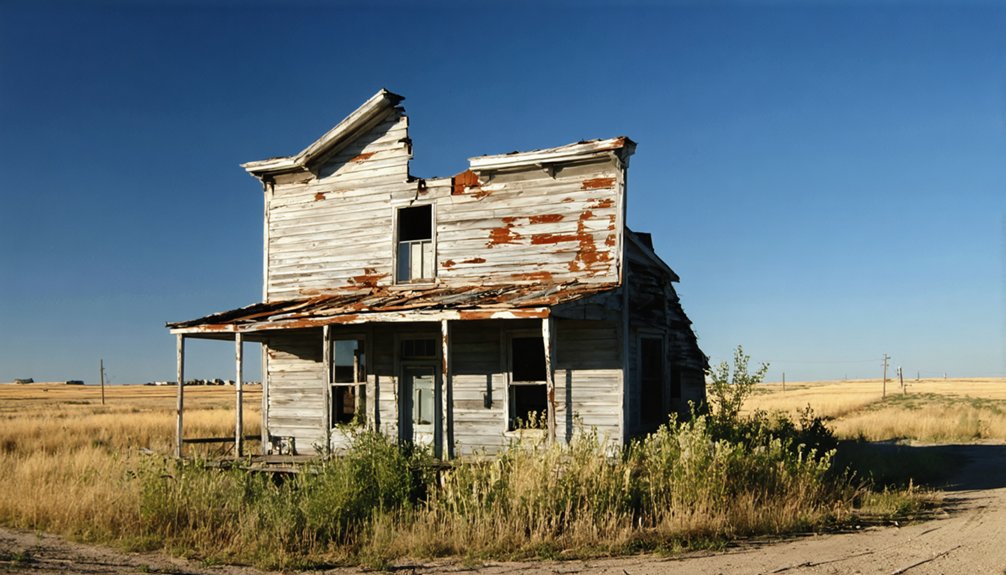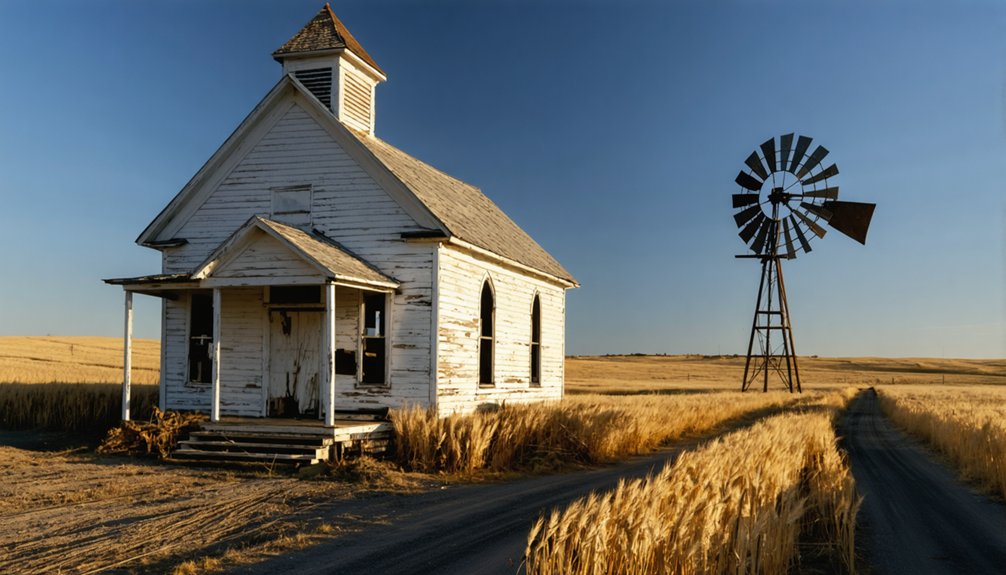You’ll discover Flora nestled in South Dakota’s Black Hills at 4,049 feet elevation, where it emerged during the 1870s gold rush. This former mining outpost reached its peak of 200 residents in the early 1900s, boasting a church, schoolhouse, and blacksmith shop. The town’s decline began after the Chicago & Northwestern Railroad’s 1907 rerouting, coupled with mining industry challenges. Today, weathered buildings and mining remnants tell a compelling pioneer story that’s waiting to be explored.
Key Takeaways
- Flora emerged during the Black Hills gold rush in the late 1800s, reaching a peak population of 200 residents in early 1900s.
- Located in Fall River County at 4,049 feet elevation, Flora was a strategic outpost for mining and logging industries.
- The town’s decline began when the Chicago & Northwestern Railroad rerouted in 1907, leading to economic collapse.
- Remnants include deteriorating buildings, mining shafts, equipment, and small gravesites from Flora’s 1890s-1930s heyday.
- The ghost town is accessible via rural roads branching from South Dakota Highways 44 and 79.
The Rise and Fall of a Black Hills Settlement
While the Black Hills gold rush of the late 1800s gave birth to numerous frontier settlements, Flora emerged as a strategic outpost serving both the mining and logging industries.
You’ll find its origins intertwined with the controversial Gold Discovery that followed Custer’s 1874 expedition, which violated Indigenous Relations established by the Fort Laramie Treaty of 1868. The settlement’s prime location near timber resources and mining sites made it a crucial hub for miners and loggers seeking supplies and services. The town’s growth reflected a painful chapter for Native Americans as sacred lands were seized for settlement and resource extraction.
Despite its promising start with essential amenities like a general store and post office, Flora’s fate was sealed by its dependence on extractive industries. The surrounding area was rich in Precambrian granite core, which characterized much of the Black Hills’ geological makeup.
Like many boomtowns, Flora discovered that relying solely on mining and logging could not guarantee lasting prosperity.
Once gold deposits dwindled and timber resources were depleted, the town couldn’t sustain itself. By mid-20th century, Flora had joined the ranks of Black Hills ghost towns.
Location and Geographic Features
You’ll find Flora nestled in Fall River County within South Dakota’s Black Hills region, where it sits at an elevation of 4,049 feet near a historically significant uranium mine.
The ghost town‘s position in the varied terrain of plains and hills reflects the typical Black Hills landscape, characterized by grasslands interspersed with forested areas. Like many ghost town sites, the area may show varying states of abandonment with few remaining visible structures.
While specific access routes aren’t well-documented, the site’s location in Fall River County suggests it’s reachable via the rural road network that connects the region’s scattered mining communities. The site is situated within National Forest land, though visitors should exercise caution regarding property access.
Regional Black Hills Setting
The Black Hills stand as an isolated mountain range stretching across western South Dakota and northeastern Wyoming, covering roughly 100 miles north-south and 50 miles east-west.
You’ll find this distinctive “Island in the Plains” rising about 3,000 feet above the surrounding grasslands, creating a unique ecological diversity that contrasts sharply with the adjacent prairies.
The region’s forested area exceeds 1.25 million acres within the Black Hills National Forest, dominated by dark green ponderosa pines that gave the range its name. The Thunder Basin grassland forms the western boundary of this remarkable geographic feature. U.S. Forest Service headquarters operate from Custer, South Dakota to manage this vast expanse.
The terrain features dramatic elevation changes, from Black Elk Peak at 7,242 feet to the surrounding plains, with limestone plateaus, deep gorges, and wide valleys characterizing the landscape.
The Cheyenne River borders the south while the Belle Fourche River defines the northern boundary.
Access Routes and Landmarks
Located within Pennington County’s rugged terrain, Flora’s historic site connects to the region through a network of rural roads branching from South Dakota Highways 44 and 79.
You’ll find the access roads shift from paved highways to gravel and dirt paths as you approach the ghost town‘s location, reflecting its remote setting in the Black Hills foothills.
The site’s elevation ranges from 3,000 to 4,000 feet above sea level, surrounded by rolling hills and mixed forest typical of the region.
While exploring, you’ll notice the landscape that once supported tin mining operations, including possible remnants of mining shafts and equipment.
Natural landmarks include small creeks and springs that were essential to the town’s operations, though many physical structures have disappeared over time.
Seasonal weather conditions can affect site accessibility, particularly during winter months.
Like nearby Etta mine, tin ore extraction was a primary industry here during the 1880s.
Similar to the development pattern of early towns that emerged near railroad lines, Flora’s location was strategically chosen to support local mining activities.
Life in Early Flora
During its peak in the early 1900s, Flora thrived as a modest farming community of roughly 200 residents nestled in South Dakota’s prairie landscape.
You’d find the community dynamics centered around essential institutions – a church with its prominent bell tower, a schoolhouse for local children, and a blacksmith shop serving the agricultural needs of residents.
Unlike many frontier towns of the era, you wouldn’t encounter any saloons or bars in Flora, though whispers of an underground brothel circulated.
The town’s agricultural practices dominated daily life, with farming implements and tools scattered across homesteads.
Fields bustled with daily farming activity as tools and equipment dotted the homesteads of Flora’s hardworking residents.
Similar to many Black Hills settlements, Flora experienced a rapid population decline as economic opportunities shifted elsewhere.
You’d see families working their land, children attending the local school, and neighbors gathering at church functions.
Much like Elrod and other communities, Flora served as a significant transportation hub for the region.
The post office’s 70-year run testified to Flora’s stability before its eventual decline.
Economic Forces Behind the Exodus
You’ll find that Flora’s rapid decline began when the Chicago & Northwestern Railroad rerouted its main line away from the town in 1907, severing essential transportation links for both commerce and passengers.
The local mining industry’s collapse in the early 1900s dealt another devastating blow, as the nearby gold and silver operations that had sustained much of the town’s economy shuttered their operations.
These twin economic forces triggered an exodus of residents and businesses, leaving Flora unable to maintain its once-thriving commercial district.
Railroad Route Changes
As South Dakota’s railroad network evolved in the late 19th and early 20th centuries, changing economic priorities and corporate consolidations dramatically altered the fate of towns like Flora.
You’ll find that railroad expansion initially drove the region’s growth, with rail miles increasing from zero in 1870 to over 2,400 by the mid-1880s.
However, economic downturns, drought, and shifting corporate strategies led to significant route changes and eventual town abandonment.
Rail companies redirected their focus westward in the early 1900s, leaving many eastern settlements isolated.
The railroads’ power to control transport routes meant that when lines were rerouted or abandoned, towns lost their economic lifeline.
For communities like Flora, being cut off from rail access fundamentally sealed their fate, as the crucial connection to markets and commerce disappeared.
Mining Industry Collapse
The decline of gold mining in South Dakota’s Black Hills region dealt a devastating blow to Flora’s survival, beginning with the rapid exhaustion of placer claims between 1874-1880.
You’ll find that as mining technology advanced, smaller operations couldn’t keep up with the capital-intensive requirements of lode mining. The town’s mines faced mounting challenges, from excessive underground water to costly infrastructure needs.
The 1929 stock market crash and subsequent economic downturns severely limited available capital for mining investments.
Flora’s mines couldn’t compete with larger, more productive districts elsewhere, while falling ore grades and resource depletion forced expensive deep mining techniques that weren’t economically viable.
Natural hazards, including floods and mine collapses, combined with price volatility in gold markets, ultimately forced mine closures and triggered an exodus of workers and their families.
Historical Landmarks and Remnants

While exploring Flora’s remaining structures today, visitors will find partially standing buildings that tell the story of this former tin mining town‘s 1890s-1930s heyday.
You’ll discover deteriorating roofs and weathered walls that showcase the architectural significance of South Dakota’s mining era. The historical preservation needs are evident in the warped wooden churches and two-story brick stores that remain standing.
Around the site, you’ll encounter remnants of the town’s industrial past, including overgrown railway infrastructure and mining artifacts.
The abandoned mines, though dangerous to explore, represent the economic foundation that once sustained this community. Small gravesites and memorial markers in the area serve as solemn reminders of the hardships faced by Flora’s early residents, including mining accidents and epidemics common to frontier settlements.
Preserving Flora’s Pioneer Legacy
Through dedicated archival work by the South Dakota Federation of Women’s Clubs, Flora’s pioneer legacy lives on in the Pioneer Daughters Collection, which features over 500 personal accounts, diaries, and oral histories from the settlement’s early days.
You’ll find women’s contributions prominently featured in these pioneer narratives, offering unique perspectives often missing from traditional historical records.
The State Historical Society actively supports preservation through educational initiatives like the “This Place Matters” essay contest and archaeology camps, connecting new generations to Flora’s heritage.
Financial support mechanisms, including the Deadwood Fund Grant and tax incentives, help maintain historic sites, while Certified Local Government programs encourage community-led preservation efforts.
Together, these resources guarantee Flora’s story remains accessible through both archival documentation and hands-on educational experiences.
Frequently Asked Questions
Are There Any Ghost Stories or Paranormal Activities Reported in Flora?
Standing where shadows dance in the prairie wind, you’ll find no documented ghost sightings or paranormal investigations in Flora. Historical records don’t mention any supernatural occurrences in this forgotten South Dakota settlement.
Can Metal Detecting or Artifact Collecting Be Done Legally in Flora?
You’ll need explicit landowner permission and proper permits due to metal detecting regulations. Artifact preservation concerns mean most collecting is restricted, and unauthorized removal could result in legal penalties.
What Wildlife and Plant Species Currently Inhabit the Abandoned Town Site?
You’ll find native prairie grasses, wildflowers, deer, rabbits, and various bird species. Wildlife observation reveals small mammals seeking shelter, while plant identification shows typical Great Plains vegetation adapting to abandoned spaces.
Does Flora Have Any Seasonal Events or Guided Historical Tours?
Despite your hopes for a Netflix-worthy ghost town experience, you won’t find seasonal festivals or historical reenactments in Flora. There’s no evidence of organized tours or events at this remote site.
You won’t find documented memory recollections or resident interviews from Flora. Available research doesn’t indicate any surviving former residents who’ve shared their experiences of living there.
References
- https://www.youtube.com/watch?v=Glucs_Rq8Xs
- https://www.sdhspress.com/journal/south-dakota-history-2-2/some-black-hills-ghost-towns-and-their-origins/vol-02-no-2-some-black-hills-ghost-towns-and-their-origins.pdf
- https://www.sdpb.org/rural-life-and-history/2023-08-21/some-black-hills-ghost-towns-and-their-origins
- https://www.youtube.com/watch?v=_0WNYsFLSLA
- https://www.youtube.com/watch?v=uCaj6m8TXv4
- https://www.onlyinyourstate.com/experiences/south-dakota/scenic-abandoned-town-sd
- https://en.wikipedia.org/wiki/List_of_ghost_towns_in_South_Dakota
- https://ghostsofnorthdakota892857007.wordpress.com/2013/03/24/flora-nd/
- https://icatchshadows.com/okaton-and-cottonwood-a-photographic-visit-to-two-south-dakota-ghost-towns/
- https://en.wikipedia.org/wiki/Black_Hills



